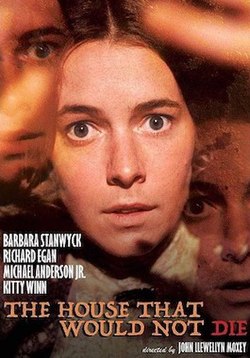Plot
Ruth Bennett has inherited an old house in Gettysburg, Pennsylvania in the Amish country, and left her career behind as a secretary at the U.S. Department of Agriculture. She moves into the home with her niece, a young woman named Sara Dunning. The house was built during the Revolutionary era and is said to be haunted by the spirits of its original inhabitants who are disinclined towards hospitality, among them the war-general, Douglas Campbell, who was suspected of being involved with British enemies, and his daughter Amanda "Ammie", who disappeared after eloping with her boyfriend Anthony.
Ruth and Sara soon meet Pat McDougal, a local professor who lives next-door. While Ruth and Sara entertain a small gathering, including Pat and one of his students, Stan, one of the guests proposes that they hold a séance in the house. Later that night, Ruth has a bizarre nightmare in which Sara approaches her in the garden, only to grow inexplicably terrified and flee in the other direction. When Ruth awakens, she finds a frightened Sara downstairs, having found an historic portrait of General Campbell impaled on a firepoker in front of the fireplace.
Pat and several guests, including medium Sylvia Wall, arrive at the home for the séance. In the kitchen, Pat aggressively forces himself on Ruth, which frightens her. During the séance, Sara begins to scream, and the painting of General Campbell falls from the mantel. That night, Ruth is awoken by Sara in another hysterical state, during which she attacks and attempts to strangle her. When Ruth consults Pat about Sara's behavior, he suspects Sarah is suffering from schizophrenia. Sara returns in the midst of their conversation, and initially appears normal, but quickly becomes transfixed in front of the fireplace, and begins screaming for help before suddenly losing consciousness. Pat suggests Sara be taken to a psychiatric hospital, but Stan objects, and reveals that, during the séance the day before, he witnessed the face of another woman on Sara's body.
Stan suspects Sara is experiencing spirit possession, which also may explain Pat's uncharacteristic behavior toward Ruth in the kitchen. Later, outside the house, Ruth, Pat, and Stan hear a man repeatedly calling, "Ammie! Come home!" Inside, they find Sara again in a distressed state. Stan begins to investigate diaries and other artifacts in the home's attic, and soon experiences supernatural incidents himself. Upon further research of historical records, the group deduce that General Campbell murdered Anthony and Ammie the night they attempted to elope, and that their spirits have been taking possession of Pat and Sara's bodies.
The group consult Sylvia to hold another séance to exorcise the spirits from Sara and Pat, which results in violent poltergeist activity that sends Sylvia fleeing in terror. While further exploring the house, Stan finds a boarded passageway in the basement. Shortly after, Pat becomes momentarily possessed by Anthony, and Sara, by Ammie. Seeking to stop the events once and for all, Ruth, Pat, Sara, and Stan convene again at the house, and break through the basement wall. Inside, they find a dirt-walled room with a shovel. Stan begins to dig, and soon recovers human bones, along with an old firepoker—the murder weapon the General used to kill Ammie and Anthony before burying them in the basement. Moments later, Pat becomes possessed by the General, and attempts to attack the possessed Sara, but he stops when Ammie—speaking through Sara's body—tells him his crime has been uncovered. Now, with the truth revealed, the spirits leave Pat and Sara's respective bodies.
